ACC30005 Taxation Law: Determining Residency and Income Source
VerifiedAdded on 2023/06/12
|17
|4144
|374
Report
AI Summary
This assignment provides a detailed analysis of taxation law, focusing on residency tests and income source determination under Australian law. It examines the residency status of Nida, a Vietnamese businesswoman who arrived in Australia in June 2017, using ordinary meaning, domicile, and 183-day tests as defined in ITAA 1936 and ITAA 1997. The assignment also discusses the implications of her residency status on the taxation of her business income. Furthermore, it explores the case of Hassan, a farmer who decides to subdivide his land for property development, assessing the proceeds from the sale of townhouses under ITAA provisions. The analysis considers whether the subdivision constitutes a mere realization of assets or a profit-making scheme. The assignment references relevant court cases and taxation rulings to support its conclusions.
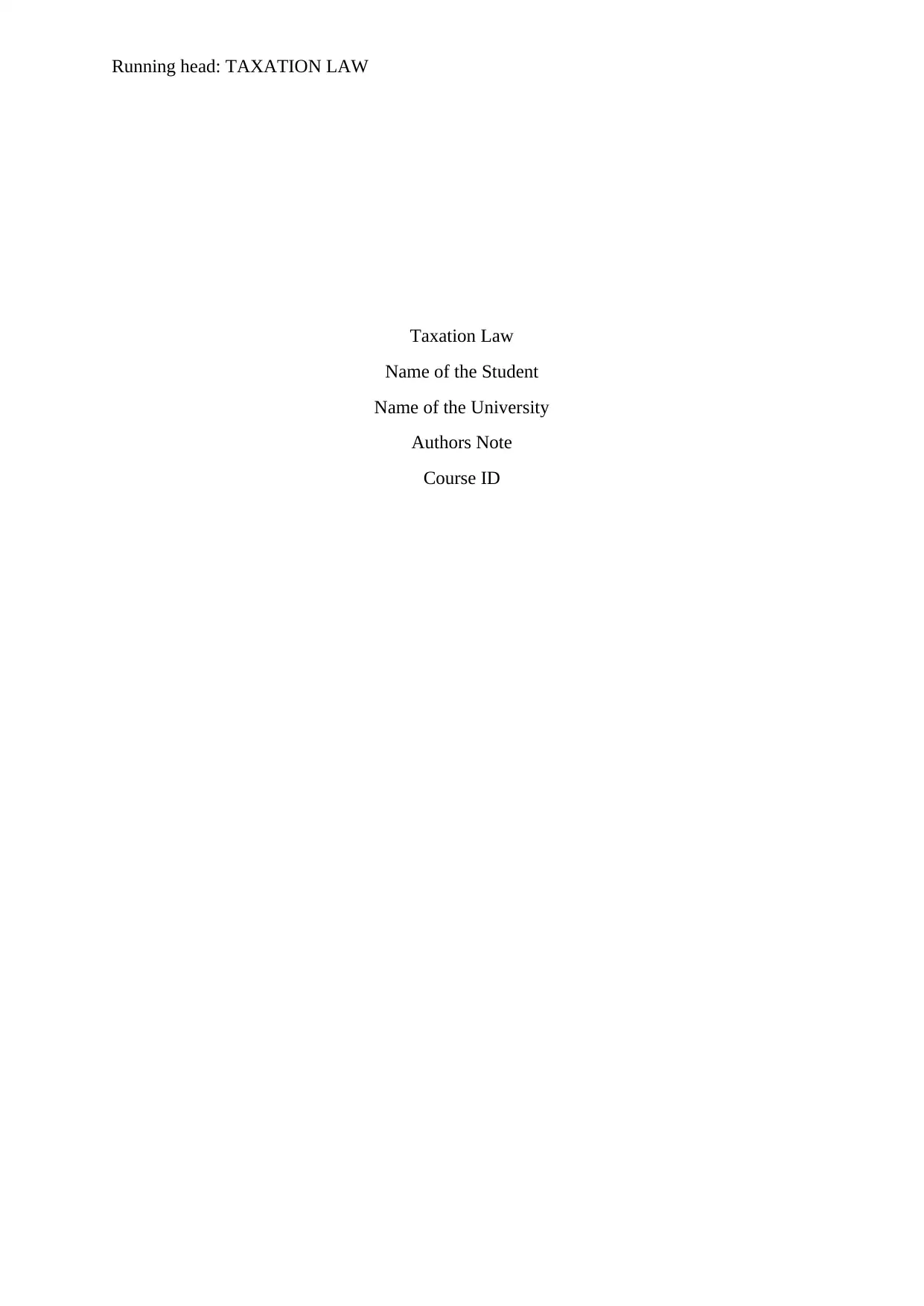
Running head: TAXATION LAW
Taxation Law
Name of the Student
Name of the University
Authors Note
Course ID
Taxation Law
Name of the Student
Name of the University
Authors Note
Course ID
Paraphrase This Document
Need a fresh take? Get an instant paraphrase of this document with our AI Paraphraser
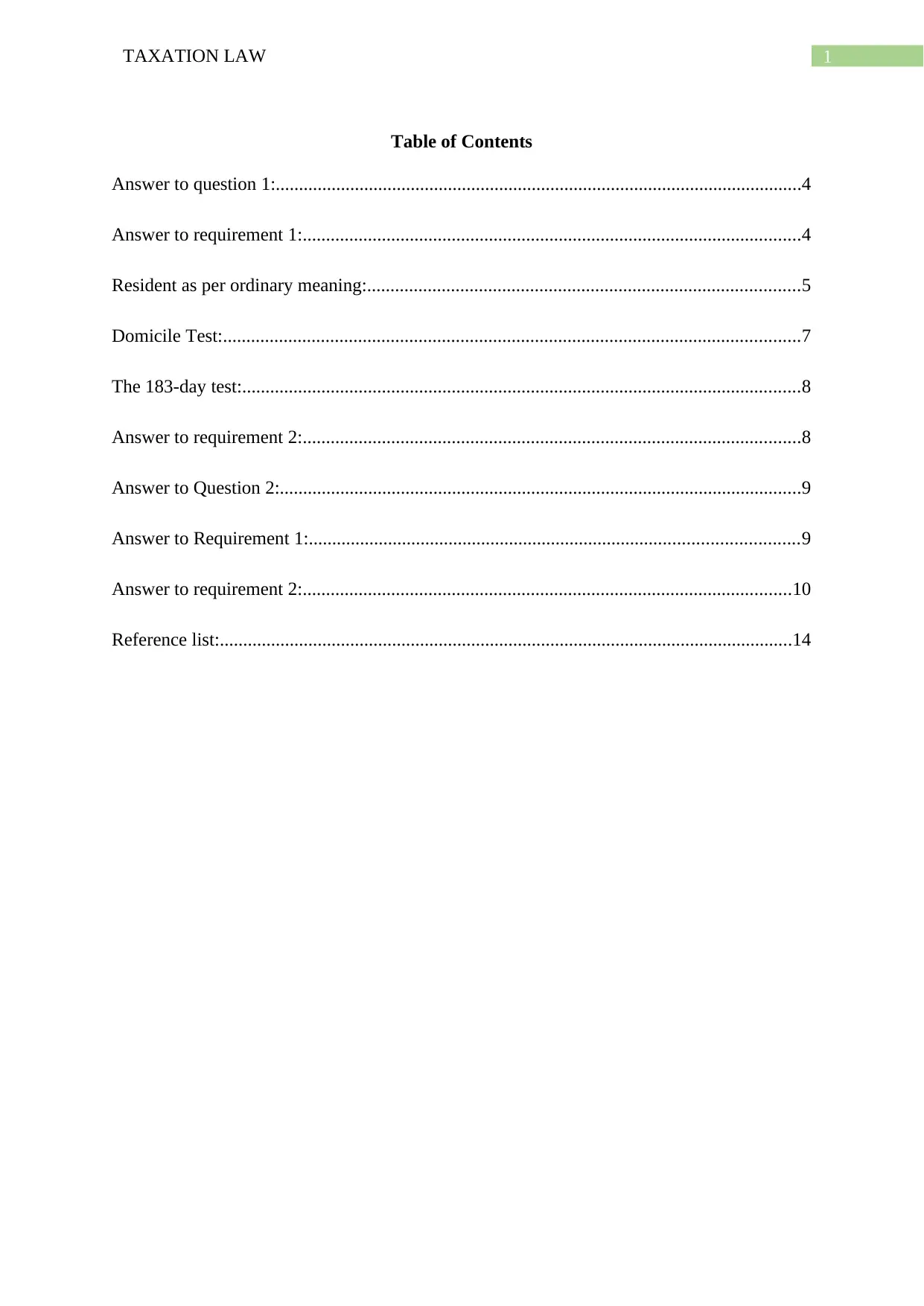
1TAXATION LAW
Table of Contents
Answer to question 1:.................................................................................................................4
Answer to requirement 1:...........................................................................................................4
Resident as per ordinary meaning:.............................................................................................5
Domicile Test:............................................................................................................................7
The 183-day test:........................................................................................................................8
Answer to requirement 2:...........................................................................................................8
Answer to Question 2:................................................................................................................9
Answer to Requirement 1:.........................................................................................................9
Answer to requirement 2:.........................................................................................................10
Reference list:...........................................................................................................................14
Table of Contents
Answer to question 1:.................................................................................................................4
Answer to requirement 1:...........................................................................................................4
Resident as per ordinary meaning:.............................................................................................5
Domicile Test:............................................................................................................................7
The 183-day test:........................................................................................................................8
Answer to requirement 2:...........................................................................................................8
Answer to Question 2:................................................................................................................9
Answer to Requirement 1:.........................................................................................................9
Answer to requirement 2:.........................................................................................................10
Reference list:...........................................................................................................................14

2TAXATION LAW
⊘ This is a preview!⊘
Do you want full access?
Subscribe today to unlock all pages.

Trusted by 1+ million students worldwide

3TAXATION LAW
Paraphrase This Document
Need a fresh take? Get an instant paraphrase of this document with our AI Paraphraser
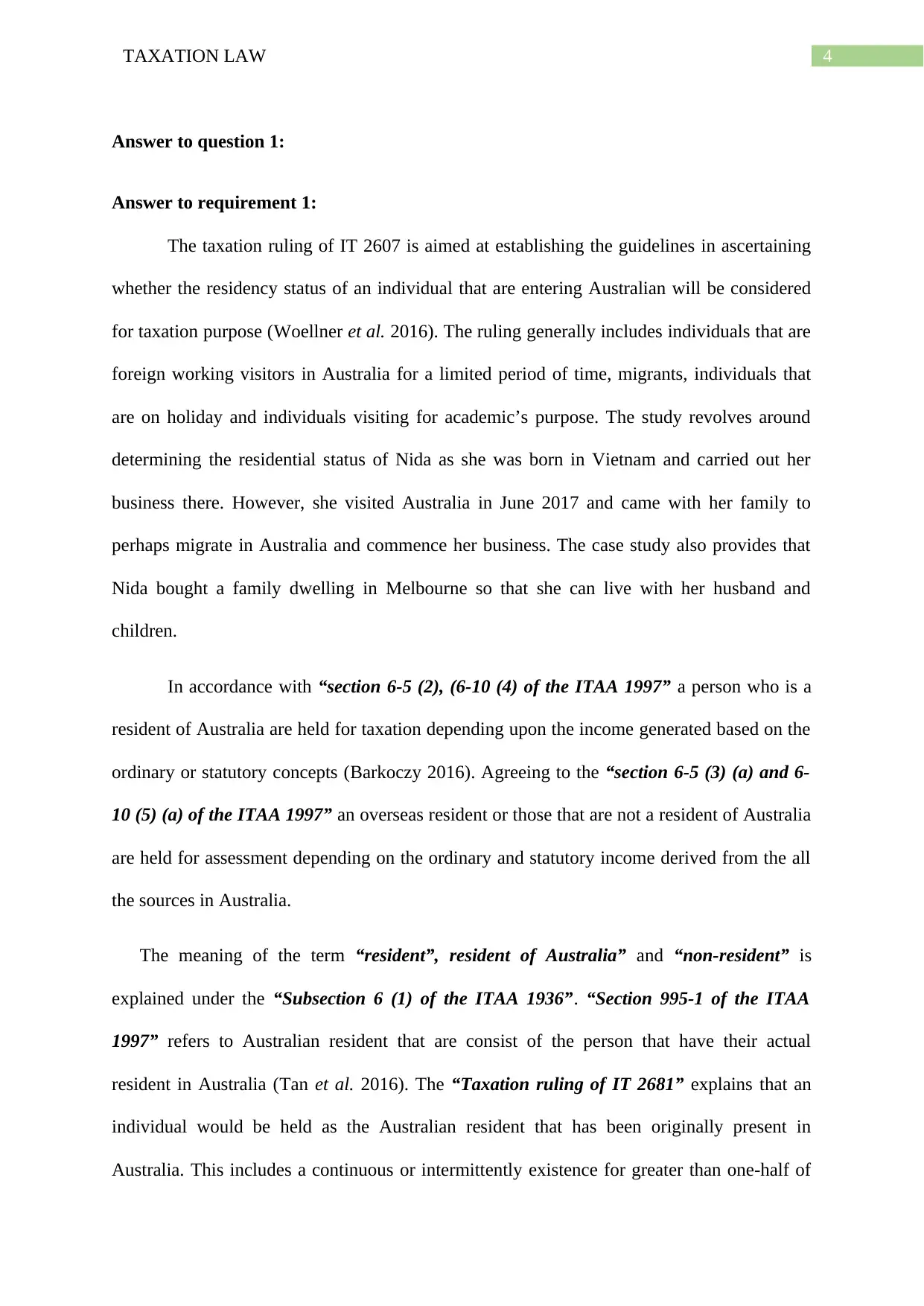
4TAXATION LAW
Answer to question 1:
Answer to requirement 1:
The taxation ruling of IT 2607 is aimed at establishing the guidelines in ascertaining
whether the residency status of an individual that are entering Australian will be considered
for taxation purpose (Woellner et al. 2016). The ruling generally includes individuals that are
foreign working visitors in Australia for a limited period of time, migrants, individuals that
are on holiday and individuals visiting for academic’s purpose. The study revolves around
determining the residential status of Nida as she was born in Vietnam and carried out her
business there. However, she visited Australia in June 2017 and came with her family to
perhaps migrate in Australia and commence her business. The case study also provides that
Nida bought a family dwelling in Melbourne so that she can live with her husband and
children.
In accordance with “section 6-5 (2), (6-10 (4) of the ITAA 1997” a person who is a
resident of Australia are held for taxation depending upon the income generated based on the
ordinary or statutory concepts (Barkoczy 2016). Agreeing to the “section 6-5 (3) (a) and 6-
10 (5) (a) of the ITAA 1997” an overseas resident or those that are not a resident of Australia
are held for assessment depending on the ordinary and statutory income derived from the all
the sources in Australia.
The meaning of the term “resident”, resident of Australia” and “non-resident” is
explained under the “Subsection 6 (1) of the ITAA 1936”. “Section 995-1 of the ITAA
1997” refers to Australian resident that are consist of the person that have their actual
resident in Australia (Tan et al. 2016). The “Taxation ruling of IT 2681” explains that an
individual would be held as the Australian resident that has been originally present in
Australia. This includes a continuous or intermittently existence for greater than one-half of
Answer to question 1:
Answer to requirement 1:
The taxation ruling of IT 2607 is aimed at establishing the guidelines in ascertaining
whether the residency status of an individual that are entering Australian will be considered
for taxation purpose (Woellner et al. 2016). The ruling generally includes individuals that are
foreign working visitors in Australia for a limited period of time, migrants, individuals that
are on holiday and individuals visiting for academic’s purpose. The study revolves around
determining the residential status of Nida as she was born in Vietnam and carried out her
business there. However, she visited Australia in June 2017 and came with her family to
perhaps migrate in Australia and commence her business. The case study also provides that
Nida bought a family dwelling in Melbourne so that she can live with her husband and
children.
In accordance with “section 6-5 (2), (6-10 (4) of the ITAA 1997” a person who is a
resident of Australia are held for taxation depending upon the income generated based on the
ordinary or statutory concepts (Barkoczy 2016). Agreeing to the “section 6-5 (3) (a) and 6-
10 (5) (a) of the ITAA 1997” an overseas resident or those that are not a resident of Australia
are held for assessment depending on the ordinary and statutory income derived from the all
the sources in Australia.
The meaning of the term “resident”, resident of Australia” and “non-resident” is
explained under the “Subsection 6 (1) of the ITAA 1936”. “Section 995-1 of the ITAA
1997” refers to Australian resident that are consist of the person that have their actual
resident in Australia (Tan et al. 2016). The “Taxation ruling of IT 2681” explains that an
individual would be held as the Australian resident that has been originally present in
Australia. This includes a continuous or intermittently existence for greater than one-half of
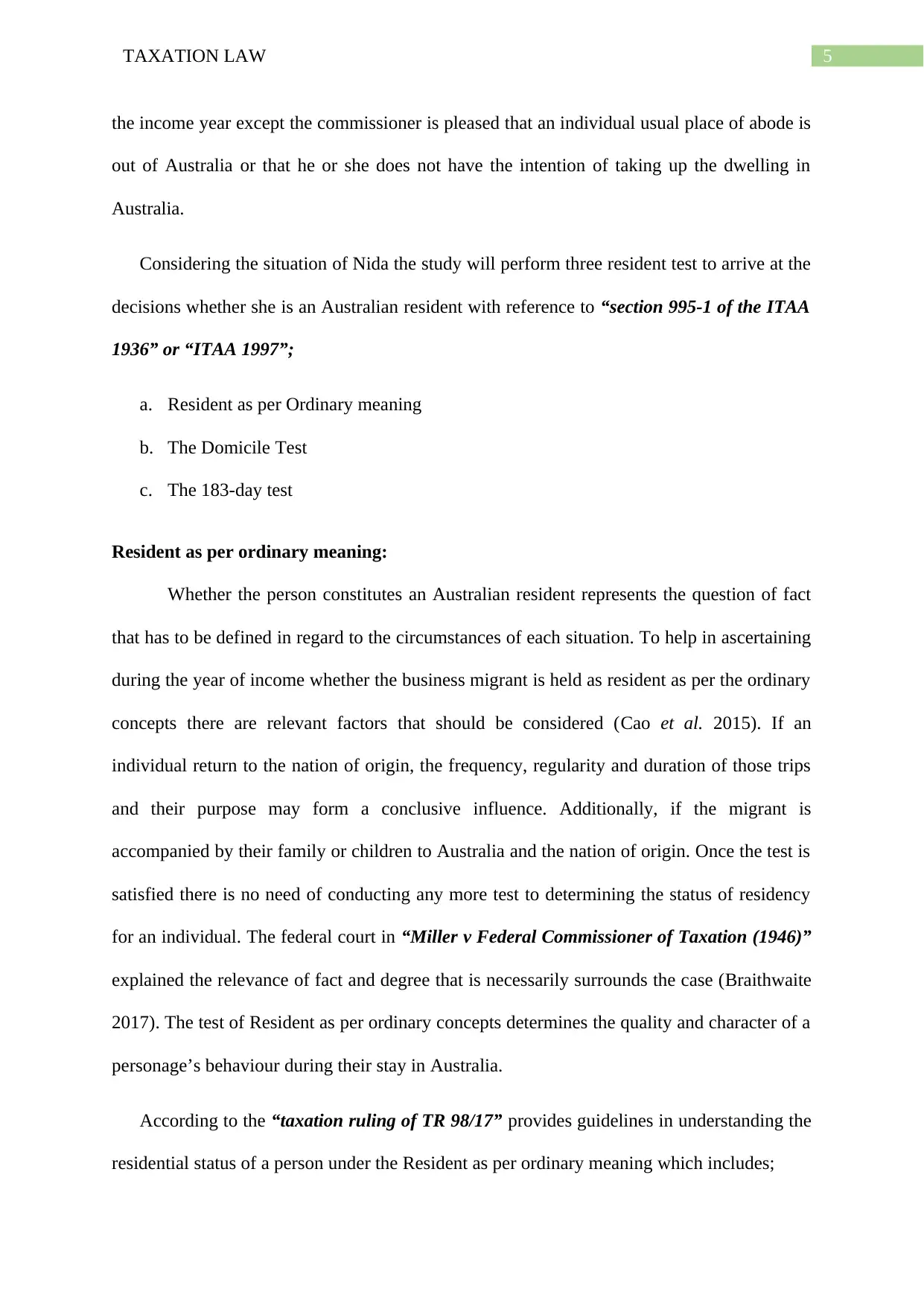
5TAXATION LAW
the income year except the commissioner is pleased that an individual usual place of abode is
out of Australia or that he or she does not have the intention of taking up the dwelling in
Australia.
Considering the situation of Nida the study will perform three resident test to arrive at the
decisions whether she is an Australian resident with reference to “section 995-1 of the ITAA
1936” or “ITAA 1997”;
a. Resident as per Ordinary meaning
b. The Domicile Test
c. The 183-day test
Resident as per ordinary meaning:
Whether the person constitutes an Australian resident represents the question of fact
that has to be defined in regard to the circumstances of each situation. To help in ascertaining
during the year of income whether the business migrant is held as resident as per the ordinary
concepts there are relevant factors that should be considered (Cao et al. 2015). If an
individual return to the nation of origin, the frequency, regularity and duration of those trips
and their purpose may form a conclusive influence. Additionally, if the migrant is
accompanied by their family or children to Australia and the nation of origin. Once the test is
satisfied there is no need of conducting any more test to determining the status of residency
for an individual. The federal court in “Miller v Federal Commissioner of Taxation (1946)”
explained the relevance of fact and degree that is necessarily surrounds the case (Braithwaite
2017). The test of Resident as per ordinary concepts determines the quality and character of a
personage’s behaviour during their stay in Australia.
According to the “taxation ruling of TR 98/17” provides guidelines in understanding the
residential status of a person under the Resident as per ordinary meaning which includes;
the income year except the commissioner is pleased that an individual usual place of abode is
out of Australia or that he or she does not have the intention of taking up the dwelling in
Australia.
Considering the situation of Nida the study will perform three resident test to arrive at the
decisions whether she is an Australian resident with reference to “section 995-1 of the ITAA
1936” or “ITAA 1997”;
a. Resident as per Ordinary meaning
b. The Domicile Test
c. The 183-day test
Resident as per ordinary meaning:
Whether the person constitutes an Australian resident represents the question of fact
that has to be defined in regard to the circumstances of each situation. To help in ascertaining
during the year of income whether the business migrant is held as resident as per the ordinary
concepts there are relevant factors that should be considered (Cao et al. 2015). If an
individual return to the nation of origin, the frequency, regularity and duration of those trips
and their purpose may form a conclusive influence. Additionally, if the migrant is
accompanied by their family or children to Australia and the nation of origin. Once the test is
satisfied there is no need of conducting any more test to determining the status of residency
for an individual. The federal court in “Miller v Federal Commissioner of Taxation (1946)”
explained the relevance of fact and degree that is necessarily surrounds the case (Braithwaite
2017). The test of Resident as per ordinary concepts determines the quality and character of a
personage’s behaviour during their stay in Australia.
According to the “taxation ruling of TR 98/17” provides guidelines in understanding the
residential status of a person under the Resident as per ordinary meaning which includes;
⊘ This is a preview!⊘
Do you want full access?
Subscribe today to unlock all pages.

Trusted by 1+ million students worldwide
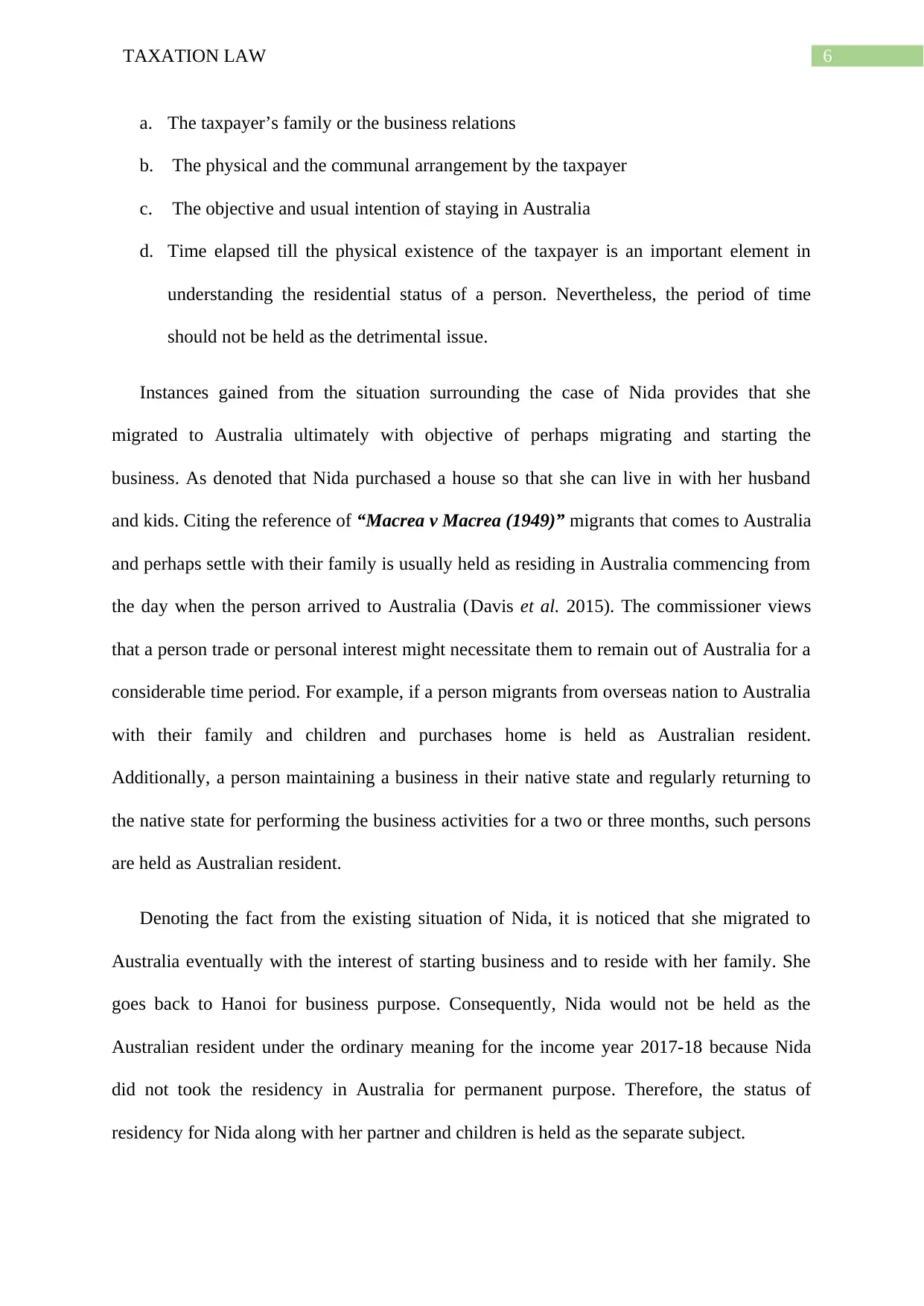
6TAXATION LAW
a. The taxpayer’s family or the business relations
b. The physical and the communal arrangement by the taxpayer
c. The objective and usual intention of staying in Australia
d. Time elapsed till the physical existence of the taxpayer is an important element in
understanding the residential status of a person. Nevertheless, the period of time
should not be held as the detrimental issue.
Instances gained from the situation surrounding the case of Nida provides that she
migrated to Australia ultimately with objective of perhaps migrating and starting the
business. As denoted that Nida purchased a house so that she can live in with her husband
and kids. Citing the reference of “Macrea v Macrea (1949)” migrants that comes to Australia
and perhaps settle with their family is usually held as residing in Australia commencing from
the day when the person arrived to Australia (Davis et al. 2015). The commissioner views
that a person trade or personal interest might necessitate them to remain out of Australia for a
considerable time period. For example, if a person migrants from overseas nation to Australia
with their family and children and purchases home is held as Australian resident.
Additionally, a person maintaining a business in their native state and regularly returning to
the native state for performing the business activities for a two or three months, such persons
are held as Australian resident.
Denoting the fact from the existing situation of Nida, it is noticed that she migrated to
Australia eventually with the interest of starting business and to reside with her family. She
goes back to Hanoi for business purpose. Consequently, Nida would not be held as the
Australian resident under the ordinary meaning for the income year 2017-18 because Nida
did not took the residency in Australia for permanent purpose. Therefore, the status of
residency for Nida along with her partner and children is held as the separate subject.
a. The taxpayer’s family or the business relations
b. The physical and the communal arrangement by the taxpayer
c. The objective and usual intention of staying in Australia
d. Time elapsed till the physical existence of the taxpayer is an important element in
understanding the residential status of a person. Nevertheless, the period of time
should not be held as the detrimental issue.
Instances gained from the situation surrounding the case of Nida provides that she
migrated to Australia ultimately with objective of perhaps migrating and starting the
business. As denoted that Nida purchased a house so that she can live in with her husband
and kids. Citing the reference of “Macrea v Macrea (1949)” migrants that comes to Australia
and perhaps settle with their family is usually held as residing in Australia commencing from
the day when the person arrived to Australia (Davis et al. 2015). The commissioner views
that a person trade or personal interest might necessitate them to remain out of Australia for a
considerable time period. For example, if a person migrants from overseas nation to Australia
with their family and children and purchases home is held as Australian resident.
Additionally, a person maintaining a business in their native state and regularly returning to
the native state for performing the business activities for a two or three months, such persons
are held as Australian resident.
Denoting the fact from the existing situation of Nida, it is noticed that she migrated to
Australia eventually with the interest of starting business and to reside with her family. She
goes back to Hanoi for business purpose. Consequently, Nida would not be held as the
Australian resident under the ordinary meaning for the income year 2017-18 because Nida
did not took the residency in Australia for permanent purpose. Therefore, the status of
residency for Nida along with her partner and children is held as the separate subject.
Paraphrase This Document
Need a fresh take? Get an instant paraphrase of this document with our AI Paraphraser
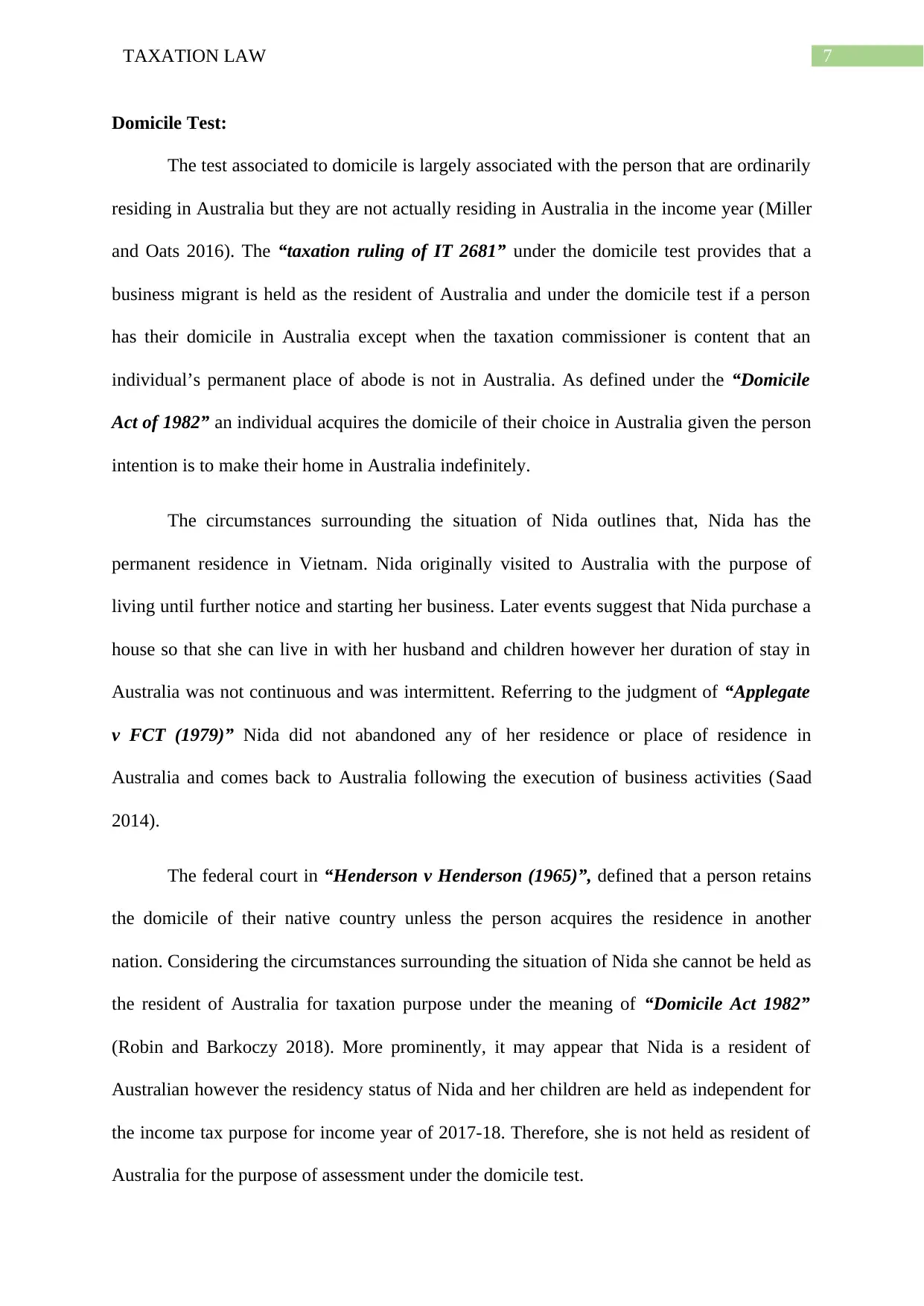
7TAXATION LAW
Domicile Test:
The test associated to domicile is largely associated with the person that are ordinarily
residing in Australia but they are not actually residing in Australia in the income year (Miller
and Oats 2016). The “taxation ruling of IT 2681” under the domicile test provides that a
business migrant is held as the resident of Australia and under the domicile test if a person
has their domicile in Australia except when the taxation commissioner is content that an
individual’s permanent place of abode is not in Australia. As defined under the “Domicile
Act of 1982” an individual acquires the domicile of their choice in Australia given the person
intention is to make their home in Australia indefinitely.
The circumstances surrounding the situation of Nida outlines that, Nida has the
permanent residence in Vietnam. Nida originally visited to Australia with the purpose of
living until further notice and starting her business. Later events suggest that Nida purchase a
house so that she can live in with her husband and children however her duration of stay in
Australia was not continuous and was intermittent. Referring to the judgment of “Applegate
v FCT (1979)” Nida did not abandoned any of her residence or place of residence in
Australia and comes back to Australia following the execution of business activities (Saad
2014).
The federal court in “Henderson v Henderson (1965)”, defined that a person retains
the domicile of their native country unless the person acquires the residence in another
nation. Considering the circumstances surrounding the situation of Nida she cannot be held as
the resident of Australia for taxation purpose under the meaning of “Domicile Act 1982”
(Robin and Barkoczy 2018). More prominently, it may appear that Nida is a resident of
Australian however the residency status of Nida and her children are held as independent for
the income tax purpose for income year of 2017-18. Therefore, she is not held as resident of
Australia for the purpose of assessment under the domicile test.
Domicile Test:
The test associated to domicile is largely associated with the person that are ordinarily
residing in Australia but they are not actually residing in Australia in the income year (Miller
and Oats 2016). The “taxation ruling of IT 2681” under the domicile test provides that a
business migrant is held as the resident of Australia and under the domicile test if a person
has their domicile in Australia except when the taxation commissioner is content that an
individual’s permanent place of abode is not in Australia. As defined under the “Domicile
Act of 1982” an individual acquires the domicile of their choice in Australia given the person
intention is to make their home in Australia indefinitely.
The circumstances surrounding the situation of Nida outlines that, Nida has the
permanent residence in Vietnam. Nida originally visited to Australia with the purpose of
living until further notice and starting her business. Later events suggest that Nida purchase a
house so that she can live in with her husband and children however her duration of stay in
Australia was not continuous and was intermittent. Referring to the judgment of “Applegate
v FCT (1979)” Nida did not abandoned any of her residence or place of residence in
Australia and comes back to Australia following the execution of business activities (Saad
2014).
The federal court in “Henderson v Henderson (1965)”, defined that a person retains
the domicile of their native country unless the person acquires the residence in another
nation. Considering the circumstances surrounding the situation of Nida she cannot be held as
the resident of Australia for taxation purpose under the meaning of “Domicile Act 1982”
(Robin and Barkoczy 2018). More prominently, it may appear that Nida is a resident of
Australian however the residency status of Nida and her children are held as independent for
the income tax purpose for income year of 2017-18. Therefore, she is not held as resident of
Australia for the purpose of assessment under the domicile test.
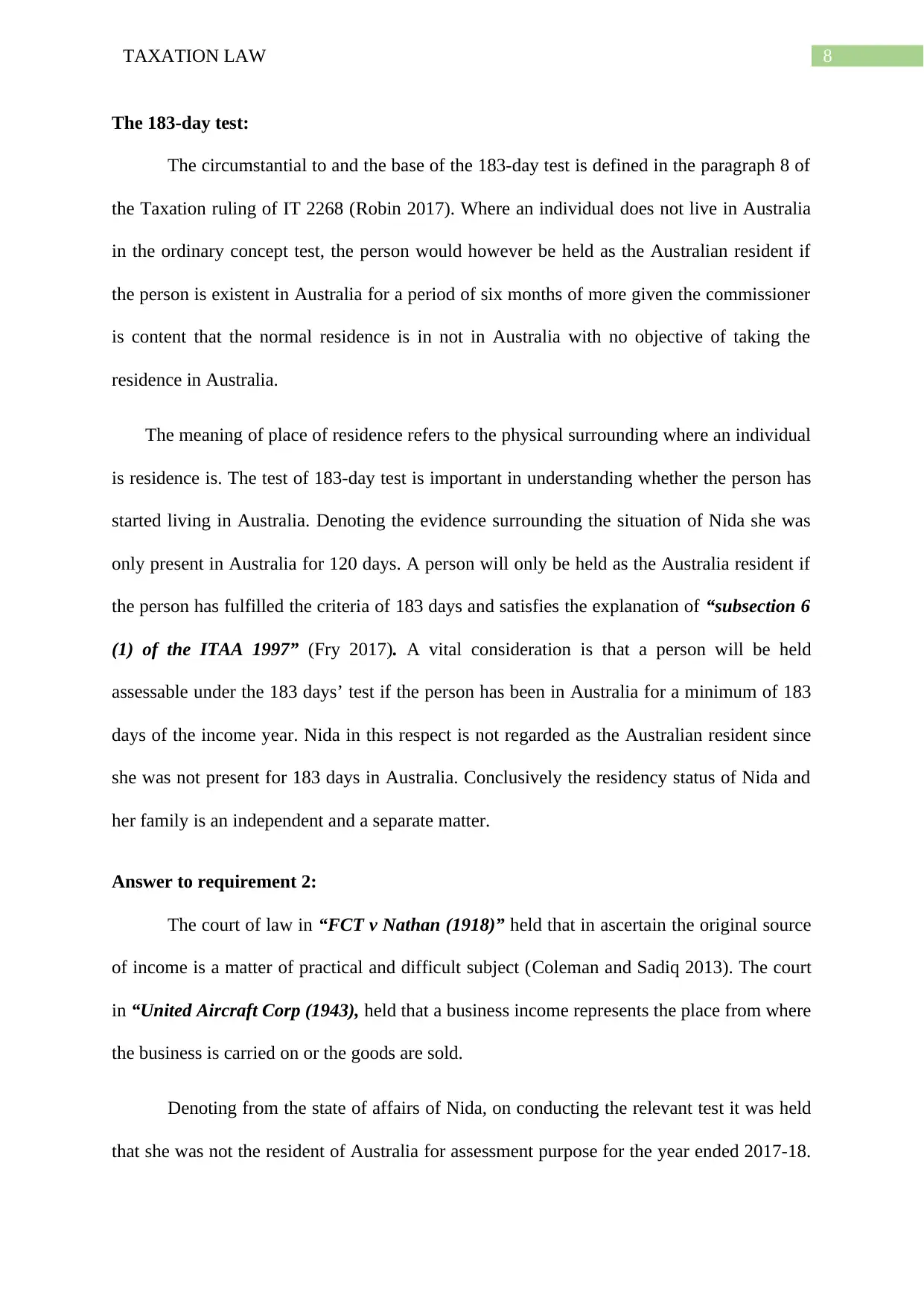
8TAXATION LAW
The 183-day test:
The circumstantial to and the base of the 183-day test is defined in the paragraph 8 of
the Taxation ruling of IT 2268 (Robin 2017). Where an individual does not live in Australia
in the ordinary concept test, the person would however be held as the Australian resident if
the person is existent in Australia for a period of six months of more given the commissioner
is content that the normal residence is in not in Australia with no objective of taking the
residence in Australia.
The meaning of place of residence refers to the physical surrounding where an individual
is residence is. The test of 183-day test is important in understanding whether the person has
started living in Australia. Denoting the evidence surrounding the situation of Nida she was
only present in Australia for 120 days. A person will only be held as the Australia resident if
the person has fulfilled the criteria of 183 days and satisfies the explanation of “subsection 6
(1) of the ITAA 1997” (Fry 2017). A vital consideration is that a person will be held
assessable under the 183 days’ test if the person has been in Australia for a minimum of 183
days of the income year. Nida in this respect is not regarded as the Australian resident since
she was not present for 183 days in Australia. Conclusively the residency status of Nida and
her family is an independent and a separate matter.
Answer to requirement 2:
The court of law in “FCT v Nathan (1918)” held that in ascertain the original source
of income is a matter of practical and difficult subject (Coleman and Sadiq 2013). The court
in “United Aircraft Corp (1943), held that a business income represents the place from where
the business is carried on or the goods are sold.
Denoting from the state of affairs of Nida, on conducting the relevant test it was held
that she was not the resident of Australia for assessment purpose for the year ended 2017-18.
The 183-day test:
The circumstantial to and the base of the 183-day test is defined in the paragraph 8 of
the Taxation ruling of IT 2268 (Robin 2017). Where an individual does not live in Australia
in the ordinary concept test, the person would however be held as the Australian resident if
the person is existent in Australia for a period of six months of more given the commissioner
is content that the normal residence is in not in Australia with no objective of taking the
residence in Australia.
The meaning of place of residence refers to the physical surrounding where an individual
is residence is. The test of 183-day test is important in understanding whether the person has
started living in Australia. Denoting the evidence surrounding the situation of Nida she was
only present in Australia for 120 days. A person will only be held as the Australia resident if
the person has fulfilled the criteria of 183 days and satisfies the explanation of “subsection 6
(1) of the ITAA 1997” (Fry 2017). A vital consideration is that a person will be held
assessable under the 183 days’ test if the person has been in Australia for a minimum of 183
days of the income year. Nida in this respect is not regarded as the Australian resident since
she was not present for 183 days in Australia. Conclusively the residency status of Nida and
her family is an independent and a separate matter.
Answer to requirement 2:
The court of law in “FCT v Nathan (1918)” held that in ascertain the original source
of income is a matter of practical and difficult subject (Coleman and Sadiq 2013). The court
in “United Aircraft Corp (1943), held that a business income represents the place from where
the business is carried on or the goods are sold.
Denoting from the state of affairs of Nida, on conducting the relevant test it was held
that she was not the resident of Australia for assessment purpose for the year ended 2017-18.
⊘ This is a preview!⊘
Do you want full access?
Subscribe today to unlock all pages.

Trusted by 1+ million students worldwide
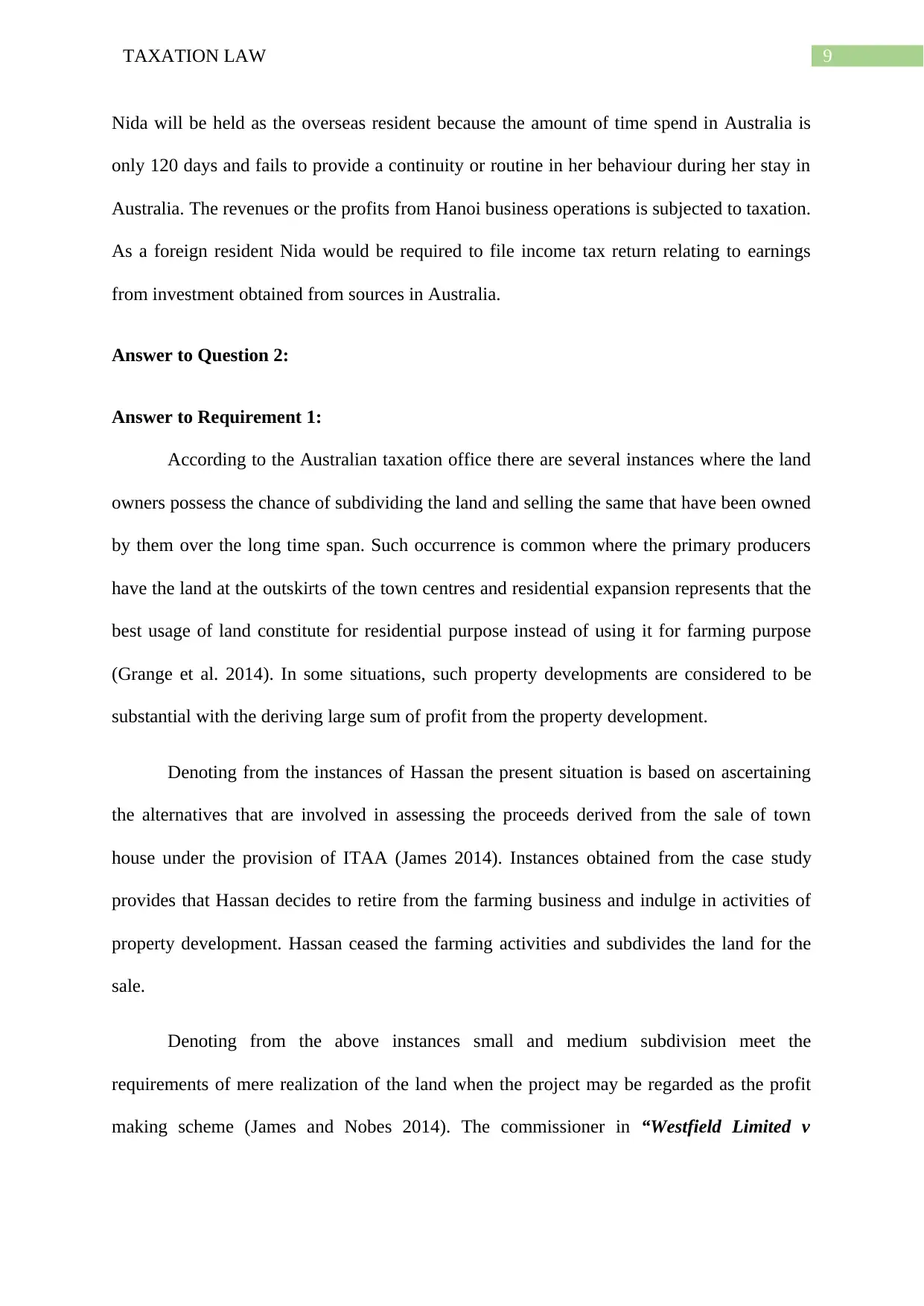
9TAXATION LAW
Nida will be held as the overseas resident because the amount of time spend in Australia is
only 120 days and fails to provide a continuity or routine in her behaviour during her stay in
Australia. The revenues or the profits from Hanoi business operations is subjected to taxation.
As a foreign resident Nida would be required to file income tax return relating to earnings
from investment obtained from sources in Australia.
Answer to Question 2:
Answer to Requirement 1:
According to the Australian taxation office there are several instances where the land
owners possess the chance of subdividing the land and selling the same that have been owned
by them over the long time span. Such occurrence is common where the primary producers
have the land at the outskirts of the town centres and residential expansion represents that the
best usage of land constitute for residential purpose instead of using it for farming purpose
(Grange et al. 2014). In some situations, such property developments are considered to be
substantial with the deriving large sum of profit from the property development.
Denoting from the instances of Hassan the present situation is based on ascertaining
the alternatives that are involved in assessing the proceeds derived from the sale of town
house under the provision of ITAA (James 2014). Instances obtained from the case study
provides that Hassan decides to retire from the farming business and indulge in activities of
property development. Hassan ceased the farming activities and subdivides the land for the
sale.
Denoting from the above instances small and medium subdivision meet the
requirements of mere realization of the land when the project may be regarded as the profit
making scheme (James and Nobes 2014). The commissioner in “Westfield Limited v
Nida will be held as the overseas resident because the amount of time spend in Australia is
only 120 days and fails to provide a continuity or routine in her behaviour during her stay in
Australia. The revenues or the profits from Hanoi business operations is subjected to taxation.
As a foreign resident Nida would be required to file income tax return relating to earnings
from investment obtained from sources in Australia.
Answer to Question 2:
Answer to Requirement 1:
According to the Australian taxation office there are several instances where the land
owners possess the chance of subdividing the land and selling the same that have been owned
by them over the long time span. Such occurrence is common where the primary producers
have the land at the outskirts of the town centres and residential expansion represents that the
best usage of land constitute for residential purpose instead of using it for farming purpose
(Grange et al. 2014). In some situations, such property developments are considered to be
substantial with the deriving large sum of profit from the property development.
Denoting from the instances of Hassan the present situation is based on ascertaining
the alternatives that are involved in assessing the proceeds derived from the sale of town
house under the provision of ITAA (James 2014). Instances obtained from the case study
provides that Hassan decides to retire from the farming business and indulge in activities of
property development. Hassan ceased the farming activities and subdivides the land for the
sale.
Denoting from the above instances small and medium subdivision meet the
requirements of mere realization of the land when the project may be regarded as the profit
making scheme (James and Nobes 2014). The commissioner in “Westfield Limited v
Paraphrase This Document
Need a fresh take? Get an instant paraphrase of this document with our AI Paraphraser
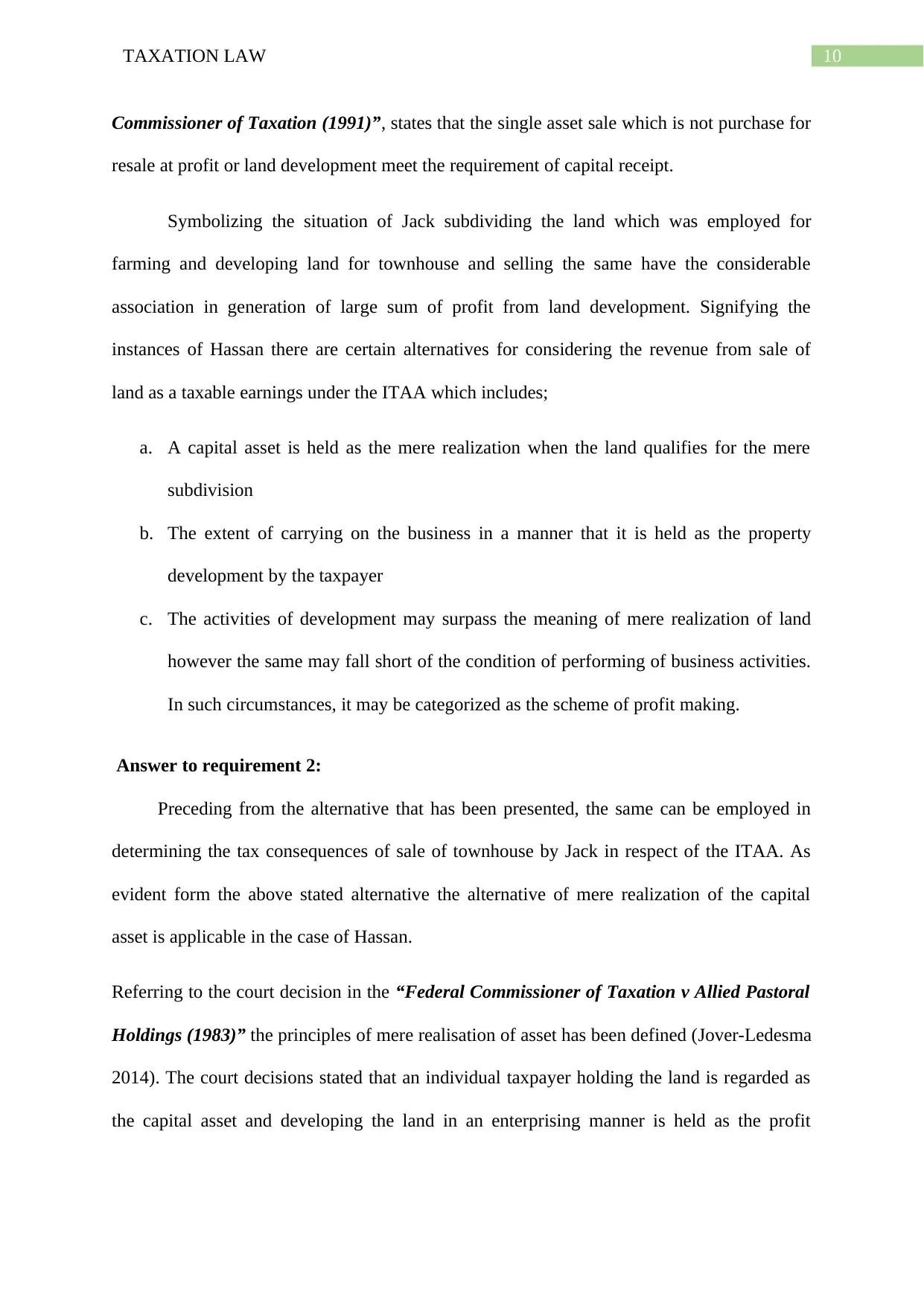
10TAXATION LAW
Commissioner of Taxation (1991)”, states that the single asset sale which is not purchase for
resale at profit or land development meet the requirement of capital receipt.
Symbolizing the situation of Jack subdividing the land which was employed for
farming and developing land for townhouse and selling the same have the considerable
association in generation of large sum of profit from land development. Signifying the
instances of Hassan there are certain alternatives for considering the revenue from sale of
land as a taxable earnings under the ITAA which includes;
a. A capital asset is held as the mere realization when the land qualifies for the mere
subdivision
b. The extent of carrying on the business in a manner that it is held as the property
development by the taxpayer
c. The activities of development may surpass the meaning of mere realization of land
however the same may fall short of the condition of performing of business activities.
In such circumstances, it may be categorized as the scheme of profit making.
Answer to requirement 2:
Preceding from the alternative that has been presented, the same can be employed in
determining the tax consequences of sale of townhouse by Jack in respect of the ITAA. As
evident form the above stated alternative the alternative of mere realization of the capital
asset is applicable in the case of Hassan.
Referring to the court decision in the “Federal Commissioner of Taxation v Allied Pastoral
Holdings (1983)” the principles of mere realisation of asset has been defined (Jover-Ledesma
2014). The court decisions stated that an individual taxpayer holding the land is regarded as
the capital asset and developing the land in an enterprising manner is held as the profit
Commissioner of Taxation (1991)”, states that the single asset sale which is not purchase for
resale at profit or land development meet the requirement of capital receipt.
Symbolizing the situation of Jack subdividing the land which was employed for
farming and developing land for townhouse and selling the same have the considerable
association in generation of large sum of profit from land development. Signifying the
instances of Hassan there are certain alternatives for considering the revenue from sale of
land as a taxable earnings under the ITAA which includes;
a. A capital asset is held as the mere realization when the land qualifies for the mere
subdivision
b. The extent of carrying on the business in a manner that it is held as the property
development by the taxpayer
c. The activities of development may surpass the meaning of mere realization of land
however the same may fall short of the condition of performing of business activities.
In such circumstances, it may be categorized as the scheme of profit making.
Answer to requirement 2:
Preceding from the alternative that has been presented, the same can be employed in
determining the tax consequences of sale of townhouse by Jack in respect of the ITAA. As
evident form the above stated alternative the alternative of mere realization of the capital
asset is applicable in the case of Hassan.
Referring to the court decision in the “Federal Commissioner of Taxation v Allied Pastoral
Holdings (1983)” the principles of mere realisation of asset has been defined (Jover-Ledesma
2014). The court decisions stated that an individual taxpayer holding the land is regarded as
the capital asset and developing the land in an enterprising manner is held as the profit
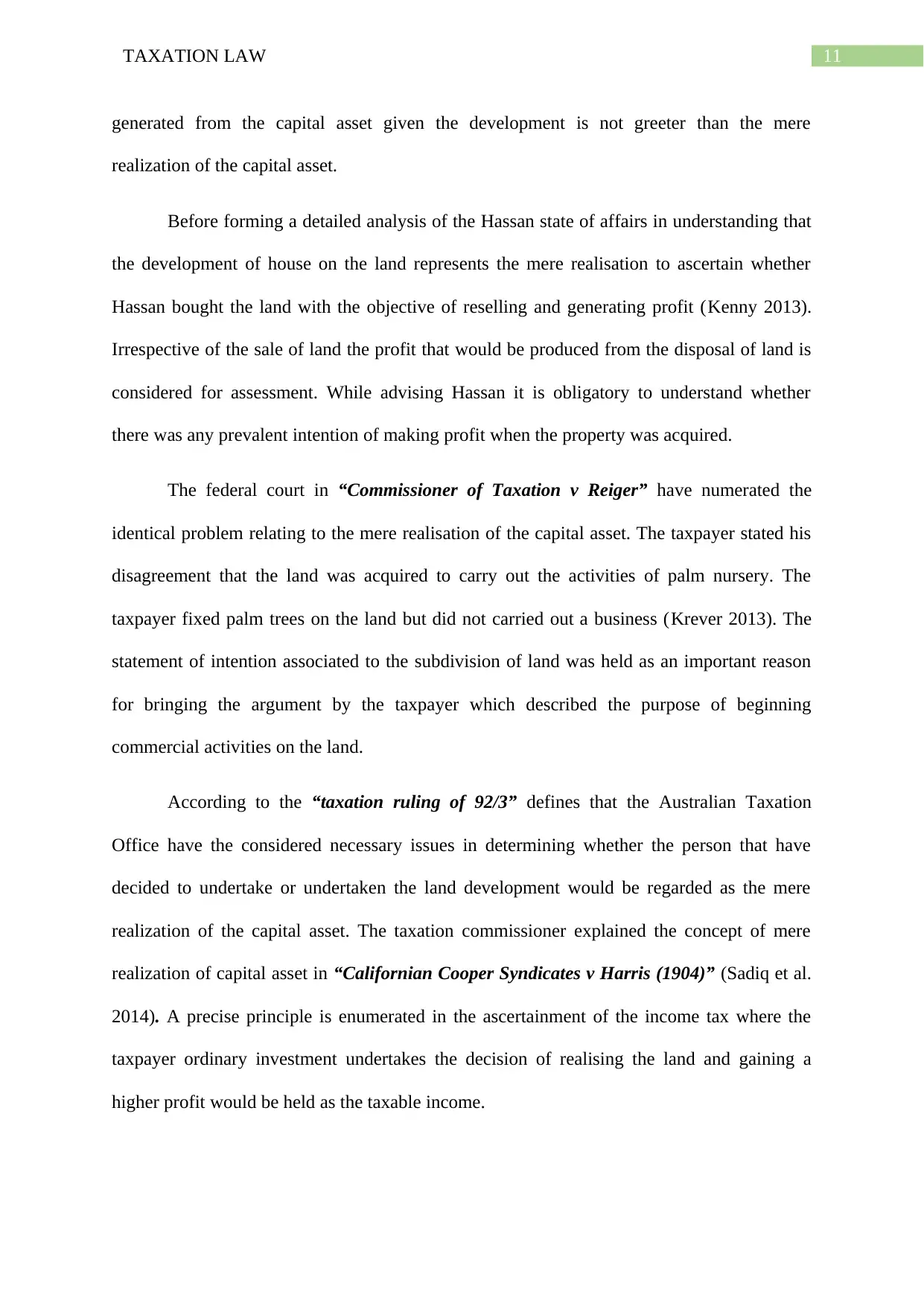
11TAXATION LAW
generated from the capital asset given the development is not greeter than the mere
realization of the capital asset.
Before forming a detailed analysis of the Hassan state of affairs in understanding that
the development of house on the land represents the mere realisation to ascertain whether
Hassan bought the land with the objective of reselling and generating profit (Kenny 2013).
Irrespective of the sale of land the profit that would be produced from the disposal of land is
considered for assessment. While advising Hassan it is obligatory to understand whether
there was any prevalent intention of making profit when the property was acquired.
The federal court in “Commissioner of Taxation v Reiger” have numerated the
identical problem relating to the mere realisation of the capital asset. The taxpayer stated his
disagreement that the land was acquired to carry out the activities of palm nursery. The
taxpayer fixed palm trees on the land but did not carried out a business (Krever 2013). The
statement of intention associated to the subdivision of land was held as an important reason
for bringing the argument by the taxpayer which described the purpose of beginning
commercial activities on the land.
According to the “taxation ruling of 92/3” defines that the Australian Taxation
Office have the considered necessary issues in determining whether the person that have
decided to undertake or undertaken the land development would be regarded as the mere
realization of the capital asset. The taxation commissioner explained the concept of mere
realization of capital asset in “Californian Cooper Syndicates v Harris (1904)” (Sadiq et al.
2014). A precise principle is enumerated in the ascertainment of the income tax where the
taxpayer ordinary investment undertakes the decision of realising the land and gaining a
higher profit would be held as the taxable income.
generated from the capital asset given the development is not greeter than the mere
realization of the capital asset.
Before forming a detailed analysis of the Hassan state of affairs in understanding that
the development of house on the land represents the mere realisation to ascertain whether
Hassan bought the land with the objective of reselling and generating profit (Kenny 2013).
Irrespective of the sale of land the profit that would be produced from the disposal of land is
considered for assessment. While advising Hassan it is obligatory to understand whether
there was any prevalent intention of making profit when the property was acquired.
The federal court in “Commissioner of Taxation v Reiger” have numerated the
identical problem relating to the mere realisation of the capital asset. The taxpayer stated his
disagreement that the land was acquired to carry out the activities of palm nursery. The
taxpayer fixed palm trees on the land but did not carried out a business (Krever 2013). The
statement of intention associated to the subdivision of land was held as an important reason
for bringing the argument by the taxpayer which described the purpose of beginning
commercial activities on the land.
According to the “taxation ruling of 92/3” defines that the Australian Taxation
Office have the considered necessary issues in determining whether the person that have
decided to undertake or undertaken the land development would be regarded as the mere
realization of the capital asset. The taxation commissioner explained the concept of mere
realization of capital asset in “Californian Cooper Syndicates v Harris (1904)” (Sadiq et al.
2014). A precise principle is enumerated in the ascertainment of the income tax where the
taxpayer ordinary investment undertakes the decision of realising the land and gaining a
higher profit would be held as the taxable income.
⊘ This is a preview!⊘
Do you want full access?
Subscribe today to unlock all pages.

Trusted by 1+ million students worldwide
1 out of 17
Related Documents
Your All-in-One AI-Powered Toolkit for Academic Success.
+13062052269
info@desklib.com
Available 24*7 on WhatsApp / Email
![[object Object]](/_next/static/media/star-bottom.7253800d.svg)
Unlock your academic potential
Copyright © 2020–2025 A2Z Services. All Rights Reserved. Developed and managed by ZUCOL.





